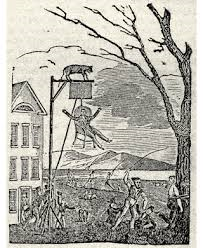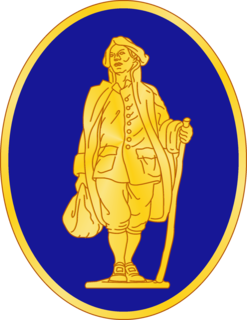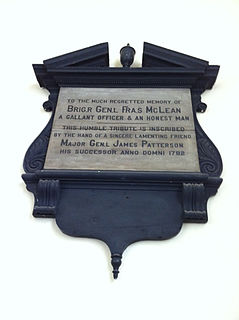
Barrimore Matthew "Barry" St. Leger was a British army officer. St. Leger was active in the Saratoga Campaign, commanding an invasion force that unsuccessfully besieged Fort Stanwix. St. Leger remained on the frontier for the duration of the war; after its conclusion, he served briefly as commander of British forces in Quebec.

The British Legion was the name of a British provincial regiment established during the American Revolutionary War, composed of British Loyalist American infantry and dragoons. It was colloquially known as Tarleton's Raiders, the Green Devils, the Green Horse, and the Green Dragoons, after the British officer who led most of its day-to-day activities, Lieutenant Colonel Banastre Tarleton, and the green uniform coats of its officers. "Legion" was an 18th-century term for a military unit the size of a regiment, but consisting of infantry and cavalry, or infantry, cavalry, and artillery, all under one command, to make it more flexible for scouting or irregular operations than a regiment, which consisted of infantry or cavalry alone.
The King's Royal Regiment of New York, also known as Johnson's Royal Regiment of New York, King's Royal Regiment, King's Royal Yorkers, and Royal Greens, were one of the first Loyalist regiments, raised on June 19, 1776, in British Canada, during the American Revolutionary War.

The siege of Pensacola was a siege fought in 1781, the culmination of Spain's conquest of the British province of West Florida during the Gulf Coast campaign.

The 84th Regiment of Foot was a British regiment in the American Revolutionary War that was raised to defend present day Ontario, Quebec and Atlantic Canada from the constant land and sea attacks by American Revolutionaries. The 84th Regiment was also involved in offensive action in the Thirteen Colonies; including North Carolina, South Carolina, Georgia, Virginia and what is now Maine, as well as raids upon Lake Champlain and the Mohawk Valley. The regiment consisted of 2,000 men in twenty companies. The 84th Regiment was raised from Scottish soldiers who had served in the Seven Years' War and stayed in North America. As a result, the 84th Regiment had one of the oldest and most experienced officer corps of any regiment in North America. The Scottish Highland regiments were a key element of the British Army in the American Revolution. The 84th Regiment was clothed, armed and accoutred the same as the Black Watch, with Lieutenant Colonel Allan Maclean commanding the first battalion and Major General John Small of Strathardle commanding the second. The two Battalions operated independently of each other and saw little action together.

The Loyal American Regiment was a British Provincial regiment raised in 1777 for Loyalist service during the American Revolutionary War. The regiment fought in many engagements throughout the war and the men were among the thousands of loyalists who settled in Nova Scotia, after the regiment disbanded in 1783.

The Queen's Rangers, also known as the Queen's American Rangers, and later Simcoe's Rangers, were a Loyalist military unit of the American Revolutionary War. Formed in 1776, they were named for Queen Charlotte, consort of George III. The Queen's Rangers served as a light corps in the tradition of British rangers during the Seven Years' War, operating on the flanks and in advance of Crown forces, manning outposts, conducting patrols, and carrying out reconnaissance and raiding operations.
The Volunteers of Ireland, also known as the 2nd American Regiment and the 105th Regiment of Foot, was a British Provincial military unit, raised for Loyalist service, during the American Revolutionary War, which was later added to the British regular army. The Volunteers of Ireland should not be confused, with the contemporaneous Irish Volunteers an autonomous militia that supported the Irish Patriot Party, in the 1770s and 1780s.

Adams' Rangers, also known as Adams’ Company of Rangers, were a British Loyalist local volunteer corps and independent military company raised to support the British Army during the American Revolutionary War. Led by Dr. Samuel Adams of Arlington, New Hampshire Grants, the Rangers made their most significant contribution to the British war effort by serving with the ill-fated Burgoyne Expedition in the Saratoga campaign of 1777.

The Siege of Ninety Six was a siege in western South Carolina late in the American Revolutionary War. From May 22 to June 18, 1781, Continental Army Major General Nathanael Greene led 1,000 troops in a siege against the 550 Loyalists in the fortified village of Ninety Six, South Carolina. The 28-day siege centered on an earthen fortification known as Star Fort. Despite having more troops, Greene was unsuccessful in taking the town, and was forced to lift the siege when Lord Rawdon approached from Charleston with British troops.
McAlpin's Corps, also known as McAlpin's Corps of Royalists and the American Volunteers, referred to either of two loyalist units in the British Army, in British Canada, commanded by Major Daniel McAlpin, during the American Revolutionary War. In most instances, the name described the American Volunteers, a corps of American Loyalists, who served in the 1777 Burgoyne Expedition, of the Saratoga Campaign. The term was also used, at times, to refer to a 'battalion' put under the command of McAlpin, in 1779, formed from the remnants of General Burgoyne's several loyalist corps, including the "American Volunteers", the King's Loyal Americans, the Queen's Loyal Rangers, and Adams' Rangers.

Associators were members of 17th- and 18th-century volunteer military associations in the British American thirteen colonies and British Colony of Canada. These were more commonly known as Maryland Protestant, Pennsylvania, and American Patriot and British Loyalist colonial militias. But unlike militias, the associator military volunteers were exempt from regular mandatory military service. Other names used to describe associators were "Associations", "Associated", "Refugees", "Volunteers", and "Partisans".
General John Campbell, 17th Chief of MacArthur Campbells of Strachur was a Scottish soldier and nobleman, who commanded the British forces at the Siege of Pensacola, and succeeded Guy Carleton, 1st Baron Dorchester as Commander-in-Chief in North America in 1783 following the end of the American War of Independence.
The 74th Regiment of (Highland) Foot or 74th Regiment of Foot was a British Army line infantry regiment from 1777 to 1784 which was raised to fight in the American Revolutionary War.

The King's Orange Rangers, also known as the Corps of King's Orange Rangers, were a British Loyalist battalion, raised in 1776 to defend British interests in Orange County, Province of New York and generally in and around the New York colony, although they saw most of their service in the Province of Nova Scotia. The battalion's commander was Lieutenant Colonel John Bayard. The Rangers had an undistinguished military record, through most of its existence, and saw very limited combat, mostly against Patriot privateers, but did play an important role in the defence of the colony of Nova Scotia in the later years of the American Revolution. The King's Orange Rangers are especially remembered for their role in the defence of Liverpool, in the Nova Scotia colony.

Brigadier General Francis McLean was a British army officer, one of two sons of Captain William Maclean and Anne Kinloch. He became famous for defending New Ireland (Maine) against the Penobscot Expedition during the American Revolution. The defeat of the Expedition was a noted British victory of the American Revolution. He was in command of the 74th Regiment of (Highland) Foot and 82nd Regiment of Foot (1778). He died 4 May 1781 at Halifax, Nova Scotia and is buried in the crypt of St. Paul's Church (Halifax). McLean never married.

The British Army during the American Revolutionary War served for eight years in campaigns fought around the globe. Defeat at the Siege of Yorktown to a combined Franco-US force ultimately led to the loss of the Thirteen Colonies in eastern North America, and the concluding Treaty of Paris deprived Britain of many of the gains achieved in the Seven Years' War. However several victories elsewhere meant that much of the British Empire remained intact.

John Ross (1744–1809) was a British Army officer in the French and Indian War and the American Revolution. He is best known for commanding a mixed force of approximately 600 regulars, Loyalists, and Indians in a raid into upstate New York on October 24, 1781 that culminated in the Battle of Johnstown, one of the last battles in the northern theater of the American Revolution. After the war, Ross was instrumental in settling Loyalist refugees in what is now the Kingston area of eastern Ontario.
The Royal North Carolina Regiment was a provincial corps of Loyalists from the Province of North Carolina during the American Revolution. Provincial corps were regiments with both British and Loyalist forces.












